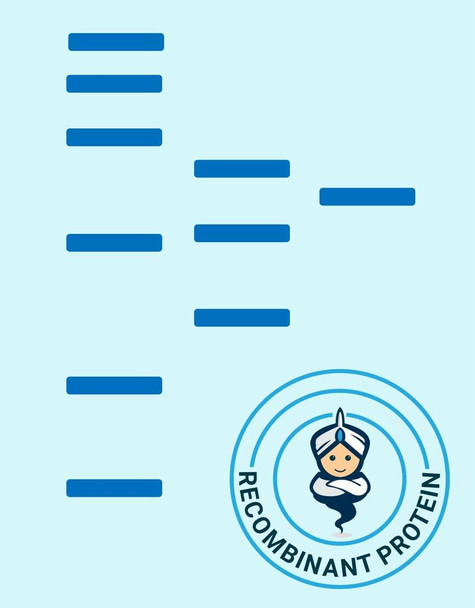Description
| Product Name: | Human NT 3 Recombinant Protein |
| Product Code: | RPPB0799 |
| Size: | 10µg |
| Species: | Human |
| Target: | NT 3 |
| Synonyms: | Neurotrophic factor, Nerve growth factor-2, NGF-2, HDNF, NT-3. |
| Source: | Escherichia Coli |
| Physical Appearance: | Sterile Filtered White lyophilized (freeze-dried) powder. |
| Formulation: | Lyophilized from 0.02% TFA. |
| Solubility: | It is recommended to reconstitute the lyophilized Neurotrophin-3 in sterile 18M?-cm H2O not less than 100�g/ml, which can then be further diluted to other aqueous solutions. |
| Stability: | Lyophilized NGF2 although stable at room temperature for 3 weeks, should be stored desiccated below -18°C. Upon reconstitution NGF-2 should be stored at 4°C between 2-7 days and for future use below -18°C.For long term storage it is recommended to add a carrier protein (0.1% HSA or BSA).Please prevent freeze-thaw cycles. |
| Purity: | Greater than 97.0% as determined by:(a) Analysis by RP-HPLC.(b) Analysis by SDS-PAGE. |
| Amino Acid Sequence: | YAEHKSHRGE YSVCDSESLW VTDKSSAIDI RGHQVTVLGE IKTGNSPVKQ YFYETRCKEA RPVKNGCRGI DDKHWNSQCK TSQTYVRALT SENNKLVGWR WIRIDTSCVC ALSRKIGRT |
| Biological Activity: | The ED50 as determined by the dose-dependent proliferation of C6 cells and is 3.6-5.4?g/ml. |
NT3 a member of the neurotrophin family, that controls survival and differentiation of mammalian neurons. This protein is closely related to both nerve growth factor and brain-derived neurotrophic factor. It may be involved in the maintenance of the adult nervous system, and may affect development of neurons in the embryo when it is expressed in human placenta. NTF3-deficient mice generated by gene targeting display severe movement defects of the limbs. The mature peptide of this protein is identical in all mammals examined including human, pig, rat and mouse.
Neurotrophin-3 Human Recombinant produced in E.Coli is a non-glycosylated and non-covalently linked homodimer, containing 2x119 amino acid chains, having a total Mw of 27.2 kDa.The NT-3 is purified by proprietary chromatographic techniques.
| UniProt Protein Function: | NT-3: Seems to promote the survival of visceral and proprioceptive sensory neurons. Belongs to the NGF-beta family. 2 isoforms of the human protein are produced by alternative splicing. |
| UniProt Protein Details: | Protein type:Cytokine; Secreted, signal peptide; Secreted Chromosomal Location of Human Ortholog: 12p13 Cellular Component: cytoplasmic membrane-bound vesicle; extracellular region Molecular Function:neurotrophin p75 receptor binding; growth factor activity; nerve growth factor binding; receptor binding; chemoattractant activity Biological Process: myelination; axon guidance; mechanoreceptor differentiation; epidermis development; glial cell fate determination; activation of MAPK activity; regulation of neuron differentiation; positive regulation of receptor internalization; positive regulation of glial cell differentiation; signal transduction; enteric nervous system development; induction of positive chemotaxis; positive chemotaxis; cell-cell signaling; positive regulation of cell proliferation; negative regulation of neuron apoptosis; regulation of synaptic transmission; negative regulation of peptidyl-tyrosine phosphorylation; nervous system development; activation of protein kinase B; positive regulation of peptidyl-serine phosphorylation; peripheral nervous system development; positive regulation of peptidyl-tyrosine phosphorylation; neuromuscular synaptic transmission; nerve development; smooth muscle cell differentiation; positive regulation of transcription from RNA polymerase II promoter; brain development; transmembrane receptor protein tyrosine kinase signaling pathway; neurite morphogenesis; positive regulation of cell migration |
| NCBI Summary: | The protein encoded by this gene is a member of the neurotrophin family, that controls survival and differentiation of mammalian neurons. This protein is closely related to both nerve growth factor and brain-derived neurotrophic factor. It may be involved in the maintenance of the adult nervous system, and may affect development of neurons in the embryo when it is expressed in human placenta. NTF3-deficient mice generated by gene targeting display severe movement defects of the limbs. The mature peptide of this protein is identical in all mammals examined including human, pig, rat and mouse. [provided by RefSeq, Jul 2008] |
| UniProt Code: | P20783 |
| NCBI GenInfo Identifier: | 128581 |
| NCBI Gene ID: | 4908 |
| NCBI Accession: | P20783.1 |
| UniProt Secondary Accession: | P20783,Q6FH50, B7Z1T5, |
| UniProt Related Accession: | P20783 |
| Molecular Weight: | 30,800 Da |
| NCBI Full Name: | Neurotrophin-3 |
| NCBI Synonym Full Names: | neurotrophin 3 |
| NCBI Official Symbol: | NTF3�� |
| NCBI Official Synonym Symbols: | NT3; HDNF; NGF2; NT-3; NGF-2�� |
| NCBI Protein Information: | neurotrophin-3; neurotrophic factor; nerve growth factor 2 |
| UniProt Protein Name: | Neurotrophin-3 |
| UniProt Synonym Protein Names: | HDNF; Nerve growth factor 2; NGF-2; Neurotrophic factor |
| Protein Family: | Neurotrophin |
| UniProt Gene Name: | NTF3�� |
| UniProt Entry Name: | NTF3_HUMAN |








